|
February/March '04
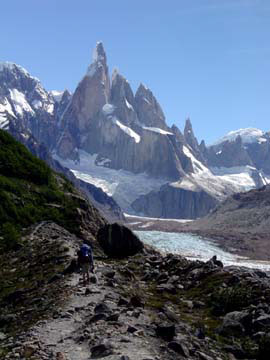 The far
southern reaches of the Americas protrude beyond any landmasses in their
stretch toward Antarctica; winds remain unhindered while lapping the globe
accruing force and moisture for delivery to the Southern Andes. Bad weather
the unfortunate norm; Why visit Patagonia, you ask? I believe Tres Torres &
the Fitzroy massif some of the planet's finest peaks, steep, aesthetic and
unhindered by thin air: If life is truly a collection of moments then the
brief vivid en route and summit views from here go straight to the bank. A
child grazing paper with pencil depicting a Mountain could easily conjure a
steep sided Dr Seuss style Cerro Torre likeness? The perfect Mountain! Unique
snow formation grace the summit, huge mushrooms resulting from cool air
traversing across a large ice-cap then meeting warm Pampa air on the
ridge-line created by Cerro Torre, Torre Egger and Cerro Standhardt:
The frosting on the three towers isn't matched across valley, Fitzroy,
Poincenot, Raphael, Exupery & De l' S offer dry routes without extensive mixed
climbing. For me the fickle elusive nature of the Torres' adds appeal; if the
weather is good sneak up try not to get noticed should the peaks become shy &
quickly redraw their weather shroud. The far
southern reaches of the Americas protrude beyond any landmasses in their
stretch toward Antarctica; winds remain unhindered while lapping the globe
accruing force and moisture for delivery to the Southern Andes. Bad weather
the unfortunate norm; Why visit Patagonia, you ask? I believe Tres Torres &
the Fitzroy massif some of the planet's finest peaks, steep, aesthetic and
unhindered by thin air: If life is truly a collection of moments then the
brief vivid en route and summit views from here go straight to the bank. A
child grazing paper with pencil depicting a Mountain could easily conjure a
steep sided Dr Seuss style Cerro Torre likeness? The perfect Mountain! Unique
snow formation grace the summit, huge mushrooms resulting from cool air
traversing across a large ice-cap then meeting warm Pampa air on the
ridge-line created by Cerro Torre, Torre Egger and Cerro Standhardt:
The frosting on the three towers isn't matched across valley, Fitzroy,
Poincenot, Raphael, Exupery & De l' S offer dry routes without extensive mixed
climbing. For me the fickle elusive nature of the Torres' adds appeal; if the
weather is good sneak up try not to get noticed should the peaks become shy &
quickly redraw their weather shroud.
From an expedition standpoint it is quick access super
Alpine terrain, town is close enough to re-supply and boulders are
plentiful with many lying just beyond the blowing rain veil. Plenty to do,
specially the ability to leave weather behind (sometimes) and certainly not
the type of venue where mandatory tent sitting slowly stirs one's mind.
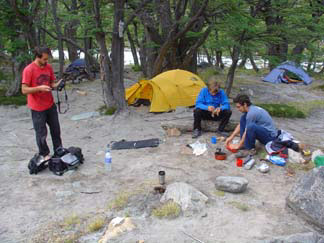 Our
goal for the Southern Hemisphere's summer '04 season was to unmask controversy
shrouding an ascent claimed on Cerro Torre's North Face in 1959: I, Leo
Houlding & Cedar Wright basically just wanted adventure from the Alpine style
challenge posed by their stated route. The story is thus: Maestri & Toni Egger
climbed crack systems via a snow patch (lower E face) then tangented
rightwards to the Col of Conquest via a crack and ramp-line. The actual North
Face he reported to have been entirely ice coated, allowing easier passage
with the crux being a section below the col, on the East side. A party climbed
Torre Egger ascending to the Col of Conquest in similar fashion, some ropes and pieces
were discovered but quite low down. Pitches directly beneath the col proved
technically easy via a hidden ramp: Contrary to the Italianís tale
dissent formed and his claim was questioned. Our
goal for the Southern Hemisphere's summer '04 season was to unmask controversy
shrouding an ascent claimed on Cerro Torre's North Face in 1959: I, Leo
Houlding & Cedar Wright basically just wanted adventure from the Alpine style
challenge posed by their stated route. The story is thus: Maestri & Toni Egger
climbed crack systems via a snow patch (lower E face) then tangented
rightwards to the Col of Conquest via a crack and ramp-line. The actual North
Face he reported to have been entirely ice coated, allowing easier passage
with the crux being a section below the col, on the East side. A party climbed
Torre Egger ascending to the Col of Conquest in similar fashion, some ropes and pieces
were discovered but quite low down. Pitches directly beneath the col proved
technically easy via a hidden ramp: Contrary to the Italianís tale
dissent formed and his claim was questioned.
Maestri stumbled alone from the base of his claim with Toni
Egger having been swept by avalanche with the camera. The ice glazed upper
section was claimed prior to the use of twin ice axes; one shoddy long handled
axe and a dagger was the eraís mode. True evidence, Maestri says, is in a
drilled rappel route down the left (East) side of the North face plus
occasional belay bolts en their ascent route. The face has seen few attempts
with only one team making serious progress beyond the col. None have found
evidence of bolts and none have succeeded on one of the ultimate Alpine
prizes.
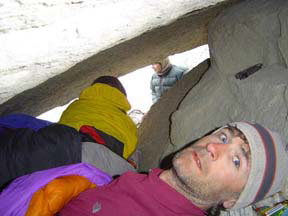 Reports of
a long weather window trickled out of the mountains as we arrived in Southern
Argentina; movement became exaggeratedly rushed in eagerness to see blue skies
over the Torre, though realistically there isn't a way to speed overland
transit. Clouds unfortunately matched our bus' speed while trundling the dirt
road towards El Chalten, offered a brief teasing glimpse before shutting the
window. Reports of
a long weather window trickled out of the mountains as we arrived in Southern
Argentina; movement became exaggeratedly rushed in eagerness to see blue skies
over the Torre, though realistically there isn't a way to speed overland
transit. Clouds unfortunately matched our bus' speed while trundling the dirt
road towards El Chalten, offered a brief teasing glimpse before shutting the
window.
Basecamp is two hours (six miles) above the rustic
yet rapidly developing town; situated at the head of the Torres valley,
immediately below a lake wrung from the glacier's snout. Its dam is the prior
terminal moraine and protects camp from wind, glacial melt providing mineral
rich drinking water straight from the river. An idyllic setting with an added
bonus of a climber built cabana, a cook and hangout zone during shoddy weather
also forming a multi-national social hub.
 Rush, rush
straight to the climb's base. One night in Chalten and one night in the
pleasant setting of basecamp, quick re-pack to set the scene for an immediate
foray up the glacial valley. Barometric pressure is the oracle for Patagonian
weather a slow rise results in a slow descent so if the peak is high
enough weather should hold, (if it takes several days to become fine it
ideally will take the same time to regress) indication swayed to brighter
skies. No lingering in Campamentto D'Agostini (aka Bridwell): A tyrolean
begins the approach spanning 150 ft across the boiling river-mouth ten yards
downstream from its birth, Laguna Torre. Steep trails enter the woods above
the Laguna gaining elevation to avoid cliffs only to loose it again down to
the glacier's tongue. Temperature at elevation can be assessed while
descending toward the glacier. Gauge comes in the form of a stream/waterfall
crossing; heavy rain or warm temperatures form a raging torrent offering
daunting, insecure passage. A quick boat ride across the Laguna would negate
most of the elevation gain, we even had a quick look in Buenos Aires but not
really time enough to find anything but Disney dinghies. Rush, rush
straight to the climb's base. One night in Chalten and one night in the
pleasant setting of basecamp, quick re-pack to set the scene for an immediate
foray up the glacial valley. Barometric pressure is the oracle for Patagonian
weather a slow rise results in a slow descent so if the peak is high
enough weather should hold, (if it takes several days to become fine it
ideally will take the same time to regress) indication swayed to brighter
skies. No lingering in Campamentto D'Agostini (aka Bridwell): A tyrolean
begins the approach spanning 150 ft across the boiling river-mouth ten yards
downstream from its birth, Laguna Torre. Steep trails enter the woods above
the Laguna gaining elevation to avoid cliffs only to loose it again down to
the glacier's tongue. Temperature at elevation can be assessed while
descending toward the glacier. Gauge comes in the form of a stream/waterfall
crossing; heavy rain or warm temperatures form a raging torrent offering
daunting, insecure passage. A quick boat ride across the Laguna would negate
most of the elevation gain, we even had a quick look in Buenos Aires but not
really time enough to find anything but Disney dinghies.
The valley is forged by three glaciers and several hanging
ones, all are dry (bare ice, visible crevasses) and all flow to the same
outlet but each has unique character specially to travel upon. The first
spills from an impressively extensive ice-fall down the eastern slope of Cerro
Adela, re-compressing at the slopes base for its final flow to the Lake. The
primary glacier is circuitous to navigate, heavily crevassed if one ventures
the Wrong way. Highlight of the first crossing is undoubtedly the climber
dubbed "Rio de la Muerte", River of Death sometimes a life changing leap,
sometimes a neat 'trekking pole' vault. Watercourses on the glacier's surface
channel into this one stream that looks like the ultimate Water-Park ride, a
deep (15ft) canyon of fast flowing, high volume, very cold water; eventually
depositing into a dark cavernous hole at least half a mile from the snout:
Hence the name. This season it proved a non event, I while chuckling to myself
remembered my first crossing, donning crampons and launching with ice axe
in-hand toward no particular landing pad: Luckily a better crossing point was
mentioned before a second venture.
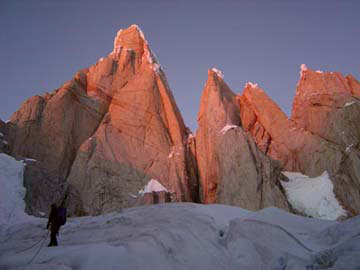 Glacier
number two flows from under the 'gob-smacking' 5000+ ft South face of Cerro
Torre, the perfect mountain. A smattering of rocks coats its surface opening
the way for quicker strides until a final gash hopping section gains access
to the moraine created by the third and final frozen flow. A flat sandy wash
hovers beyond this moraine (gravel hills) a beach amid mountains, sandwiched
between Poincenot and El Mocho (the Torre's footstool), surrounded by tall
needles it's the turning point for peak choice: Up and left for Cerro Torre,
Egger & Standhardt or right for Poincenot, Raphael, Exupery & De l' S. Glacier
number two flows from under the 'gob-smacking' 5000+ ft South face of Cerro
Torre, the perfect mountain. A smattering of rocks coats its surface opening
the way for quicker strides until a final gash hopping section gains access
to the moraine created by the third and final frozen flow. A flat sandy wash
hovers beyond this moraine (gravel hills) a beach amid mountains, sandwiched
between Poincenot and El Mocho (the Torre's footstool), surrounded by tall
needles it's the turning point for peak choice: Up and left for Cerro Torre,
Egger & Standhardt or right for Poincenot, Raphael, Exupery & De l' S.
There is no real outlet from the valley; it ends in a
cascading cirque. High camp's accommodation is provided by hospitable boulder
caves Polakos (Polish bivi) lies in a sandy boulder strewn valley/ditch below
Poincenot. Our bivi of intent Norwegos (Norwegian) lay a further hour
(2000ft) up loose talus directly below Media Luna and the tongue of the
snowy glacier guarding the three towers.
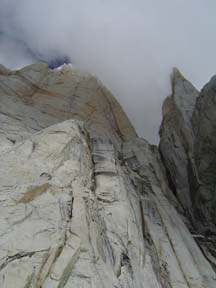 Steep
gravel relinquishes the sole flat-spot to a collection of large boulders, over
seasons of high wind and rain their users have been forced to
further excavate caves and fabricate walls: Quite homely when not churning in
cloud. Our first morning in Norwegos brought murk and drizzle with threatening
skies, the Barometer bumped up and down so we recouped, festered and fed away
our first real 'rest' day. Early evening saw the barometer raise again, a
strange bumpy graph but positive never-the-less. Exiting Norwegos for the
climb requires spiky feet and umbilical attached team mates. Snow hides the
gaping holes of the Torres glacier rather admirably; large bridges and heavily
sloughed areas are inevitable. Early morning is preferred transit time, it's
much better to be riding atop the crisp frozen snow wearing crampons than
dragging heavy feet out of trenches after the sun has churned the surface. An
hour and a half of marching sees one at the beginning of technical climbing.
The Maestri/Egger cracks straight out of the ice negotiate the bergschrund's
gap and youíre on it. A climb of two distinct characters on two separate
facets of the mountain: Two thousand, plus feet on the east face into the Col
of Conquest between the north face and Torre Egger then a similar more
technical length on the north face. Steep
gravel relinquishes the sole flat-spot to a collection of large boulders, over
seasons of high wind and rain their users have been forced to
further excavate caves and fabricate walls: Quite homely when not churning in
cloud. Our first morning in Norwegos brought murk and drizzle with threatening
skies, the Barometer bumped up and down so we recouped, festered and fed away
our first real 'rest' day. Early evening saw the barometer raise again, a
strange bumpy graph but positive never-the-less. Exiting Norwegos for the
climb requires spiky feet and umbilical attached team mates. Snow hides the
gaping holes of the Torres glacier rather admirably; large bridges and heavily
sloughed areas are inevitable. Early morning is preferred transit time, it's
much better to be riding atop the crisp frozen snow wearing crampons than
dragging heavy feet out of trenches after the sun has churned the surface. An
hour and a half of marching sees one at the beginning of technical climbing.
The Maestri/Egger cracks straight out of the ice negotiate the bergschrund's
gap and youíre on it. A climb of two distinct characters on two separate
facets of the mountain: Two thousand, plus feet on the east face into the Col
of Conquest between the north face and Torre Egger then a similar more
technical length on the north face.
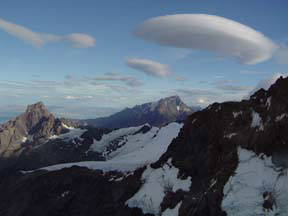
Skies remained clear as we hovered at the base with
Barometric pressure plummeting rapidly, always a bad sign in this region,
wavering our psyche to the point where we waited to see what would
happen? Something tangible became necessary before movement up or down
would initiate: Clouds split against the backside (West face) of Cerro Torre
and began to boil into the valley we turned and ran all the way to basecamp.
Clouds continued spilling into the valley stalled then backed out. Base to
high-camp (Norwegos) is four or five hours under a heavy load, two hours
unladen at the very least. We had arrived back into Campamentto Bridwell under
a darkening sky yet within an hour it cleared. Weather was leading us quite a
dance not the normal white wall snow/rain or fair. The barometer bobbed up and
down as clouds rolled in and out, yet a universal mountain rule seems to be
when itís clear, gotta go. Only a short nights rest then back up to
the boulder caves just in time for the clouds to again spit rain & engulf the
valley. That night each of the cavernous grottos chosen for sleep leaked
considerably and it felt like we were under the landing lights of a bustling
airport. Gusts would rip through the valley as if a 747 were grazing within
feet of the bivi site, in turn seemingly driving rain straight through the
granite.
The weather's wavering pattern continued; neither truly
horrible nor good, plenty of snow and wind but not quite slipping into full
tempest. We remained in Norwegos waiting again for the tangible indicator; it
certainly wasn't climbing weather but neither did it ferociously drive us out.
Day three in the cave was my break-point, there wasn't enough room to sit up,
one's feet were jammed into an acute slot severely restricting movement, one
person could comfortably lie within but we were three! Attempting to cook
without torching sleeping or bivi bags required a huge concerted effort,
settling into this scene on morning three it felt to be wearing thin; after
caffeine all were ready to don the Gore-Tex and improve comfort levels in
basecamp.
This can be a frustrating range to climb in, usually a
waiting game but this time we were being forced to march up a down valley as
if someone were controlling it all from a vantage point and never tiring of
the joke.
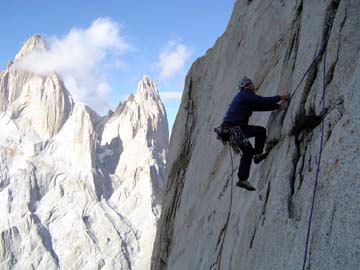 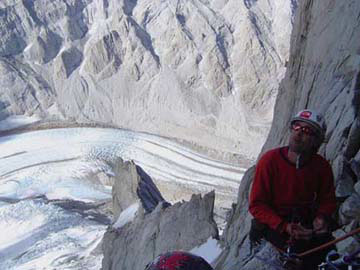 The
next time at Norwegos poised to climb; Leo asked. "What's your worst recent
moment"? For some strange reason I couldn't conjure any climbing scenarios
and remembered a night in Manchester's Musicbox: Good club, great tunes,
awesome crowd, I stepped into the toilet's (that's its name in Britain, who's
foolin' who we don't rest there?) usual derelict scene, people waiting but a
free unit? The vertically oriented, wall mounted individual kind: Relief was
mine as I noticed the washed out sign, 'Don't Use!' timed perfectly with the
cistern releasing its flush into the whole row. Mines front was broken off,
that little lip that prevents the contents being gathered by the flush and
ejected onto one's crotch, yes it wasn't there! "What the hell's that got to
do with climbing?" Leo blurted back? I look across valley at the seracs
between Fitzroy and Poincenot, "I remember watching those Seracs fall", I say,
First time I came here; we'd just climbed the Torre & Standhardt and were
hiking everything back to basecamp. Nowhere in the gully was safe from falling
ice, the following visit myself and Alan Mullin descended the same gully after
climbing Fitzroy. Guess all I'm saying is a selective memory really helps one
be optimistic? Either that or the worst that can happen never quite does and
memory flushes these moments in a form of self preservation, if all was
considered would ascent still be rational? Here we were poised; weather
looking okay, psyched and running through the list of what makes it safe to
climb this famously dangerous route in current conditions, everything pieced
together, this IS the time! As I subconsciously tallied the perils and
quashed each Leo's delivered his question, after all had been rationalised and
stepped past? If one cannot asses the dangers inherent in the game, whatever
the game may be, it must surely minimise a practitioners playing time? The
next time at Norwegos poised to climb; Leo asked. "What's your worst recent
moment"? For some strange reason I couldn't conjure any climbing scenarios
and remembered a night in Manchester's Musicbox: Good club, great tunes,
awesome crowd, I stepped into the toilet's (that's its name in Britain, who's
foolin' who we don't rest there?) usual derelict scene, people waiting but a
free unit? The vertically oriented, wall mounted individual kind: Relief was
mine as I noticed the washed out sign, 'Don't Use!' timed perfectly with the
cistern releasing its flush into the whole row. Mines front was broken off,
that little lip that prevents the contents being gathered by the flush and
ejected onto one's crotch, yes it wasn't there! "What the hell's that got to
do with climbing?" Leo blurted back? I look across valley at the seracs
between Fitzroy and Poincenot, "I remember watching those Seracs fall", I say,
First time I came here; we'd just climbed the Torre & Standhardt and were
hiking everything back to basecamp. Nowhere in the gully was safe from falling
ice, the following visit myself and Alan Mullin descended the same gully after
climbing Fitzroy. Guess all I'm saying is a selective memory really helps one
be optimistic? Either that or the worst that can happen never quite does and
memory flushes these moments in a form of self preservation, if all was
considered would ascent still be rational? Here we were poised; weather
looking okay, psyched and running through the list of what makes it safe to
climb this famously dangerous route in current conditions, everything pieced
together, this IS the time! As I subconsciously tallied the perils and
quashed each Leo's delivered his question, after all had been rationalised and
stepped past? If one cannot asses the dangers inherent in the game, whatever
the game may be, it must surely minimise a practitioners playing time?
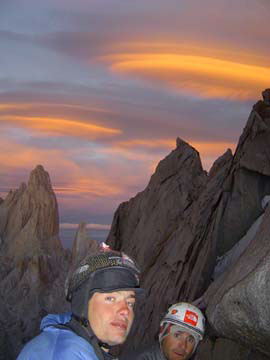 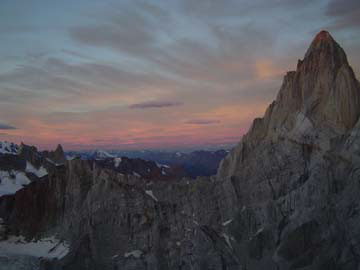 Attempts
to awake at three am never came to fruition, alarms were set but nobody
accepted accountability. We discovered within the group that setting alarms
had no effect unless coffee duty and alarm recognition had been assigned.
Think we all awoke at three and tried not to stir should someone comment thus
initiating the day: By five we were in motion leaving Norwegos for the
Maestri/Egger, round two and this time the glacier hadn't reconsolidated we
sank into heavy, wet snow. The previous night had been a virtual fire fall
boulders constantly ricochet down the cross-valley gullies causing bright
sparks with disturbing regularity. Warm wet weather was causing rapid local
evolution. It had favourably stripped our intended climb of almost all the
usual overhanging, threatening snow/ice blobs. Unfortunately evolution was
still evident as we drew under the East face. Ice blocks and rocks cascaded
from all points, small barrages initially; the extra hour in bed looked to
have saved our skins! Sun warmed the Tower, its response was to find larger
chunks to cast down with increased vigour. Had we arose at three we'd have been a
pitch or two up without the ability to dodge what became a constant barrage.
Nowhere on the route was proving safe from missiles, even saw sloughs from the Torre's North face leap to the Egger and rebound with more debris into the
col. Spectacular but unapproachable! Attempts
to awake at three am never came to fruition, alarms were set but nobody
accepted accountability. We discovered within the group that setting alarms
had no effect unless coffee duty and alarm recognition had been assigned.
Think we all awoke at three and tried not to stir should someone comment thus
initiating the day: By five we were in motion leaving Norwegos for the
Maestri/Egger, round two and this time the glacier hadn't reconsolidated we
sank into heavy, wet snow. The previous night had been a virtual fire fall
boulders constantly ricochet down the cross-valley gullies causing bright
sparks with disturbing regularity. Warm wet weather was causing rapid local
evolution. It had favourably stripped our intended climb of almost all the
usual overhanging, threatening snow/ice blobs. Unfortunately evolution was
still evident as we drew under the East face. Ice blocks and rocks cascaded
from all points, small barrages initially; the extra hour in bed looked to
have saved our skins! Sun warmed the Tower, its response was to find larger
chunks to cast down with increased vigour. Had we arose at three we'd have been a
pitch or two up without the ability to dodge what became a constant barrage.
Nowhere on the route was proving safe from missiles, even saw sloughs from the Torre's North face leap to the Egger and rebound with more debris into the
col. Spectacular but unapproachable!
I was steered by compadres into repeating the Compressor
route, Cerro Torre's South East arÍte, frankly little else was safe.
Climbing begins in the same glacial cirque, usually via a
steep snow slope to a single pitch of mixed climbing, this season the warm
conditions had collapsed the entire snow slope requiring one to stay only on
rock. Seven 60m pitches a 5.9 move or two but never sustained. The shoulder
drew closer as cloud did the same around the Torre's summit. Plan 'C' dropped
into effect a small spire east of the shoulder an unclimbed Patagonian summit!
The Compressor route takes off up the spectacular soaring arÍte/ridge and was
already engulfed: A single 5.10 pitch and a ridge traverse attained our fresh
summit "Cerro Pereyra", named in memory of a good mutual friend who died while
climbing in Mexico.
Rain then flushed us from the high-camp's caves and
remained in-situ; town ventures became more frequent we started accruing
boulder problems in Madsen camp and hiking back and forth for further bonsai
projects and rain avoidance. The camp's cabana is a sweet hang out but does
drip after time.
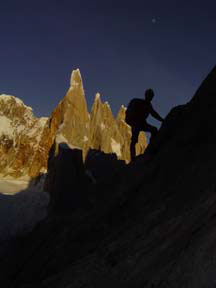  Climatic
conditions looked to be firmly enforcing their normal mode, debate about gear
retrieval became choice topic. Town became lean of climbers and after
a week we were solely left holding the torch for summit desires. Newly
delivered internet connection proved a useful tool in predicting weather and
right before leaving the vigil was fruitful: A small high pressure system
was bumped south for just long enough to poach an ascent. Cerro Torre and
Fitzroy remained under their rime ice cloaks so we picked a more rapidly
achievable objective in Aguja de l' S' West face. Shortest summit on the West
facing side of the valley yet one of the longer climbs due to its
technicalities beginning at glacier level instead of threshing 3000ft up a
loose gully to the first pitch. A truly enjoyable loooong moderate route and
first ascent of the four thousand+ foot (1200m) face, "The Thaw's not Houlding
Wright" V 5.10. First section of climbing is a ridge/arÍte of perfect rock
formed on the left side of a larger buttress: We kept ropes in the packs and
free-soloed up to the upper headwall. Some of the finest easy climbing ever!
The highlight was a short 5.6 arÍte; lay-backing the square-cut, low angle edge
was the mode, all with an admirable view of the glacier a couple of thousand
feet below. The testy looking upper headwall relinquished passage via a series
of thin cracks just to the left of the main feature, a long rust streak, never
desperate, fun high quality rock climbing with a 5.10 section or two per
pitch; requiring ten stretched 60m pitches. Upon mounting the summit we saw
the true summit, in turn traversed a fine ridge encompassing both high-points
then rappelled the North side of our second summit onto a plateau (Aguja
De l' S West face topo). One further
rappel accessed St Exupery's gully and rope-work was finalised. Satisfaction
from a steep journey absorbed in the expedition's dwindling hours! Fuel for
the fire, not the main prize but more moments for the bank and Jose Luis Pereyra's
impression on us all will reside with his name on a Southern Andean tower. Climatic
conditions looked to be firmly enforcing their normal mode, debate about gear
retrieval became choice topic. Town became lean of climbers and after
a week we were solely left holding the torch for summit desires. Newly
delivered internet connection proved a useful tool in predicting weather and
right before leaving the vigil was fruitful: A small high pressure system
was bumped south for just long enough to poach an ascent. Cerro Torre and
Fitzroy remained under their rime ice cloaks so we picked a more rapidly
achievable objective in Aguja de l' S' West face. Shortest summit on the West
facing side of the valley yet one of the longer climbs due to its
technicalities beginning at glacier level instead of threshing 3000ft up a
loose gully to the first pitch. A truly enjoyable loooong moderate route and
first ascent of the four thousand+ foot (1200m) face, "The Thaw's not Houlding
Wright" V 5.10. First section of climbing is a ridge/arÍte of perfect rock
formed on the left side of a larger buttress: We kept ropes in the packs and
free-soloed up to the upper headwall. Some of the finest easy climbing ever!
The highlight was a short 5.6 arÍte; lay-backing the square-cut, low angle edge
was the mode, all with an admirable view of the glacier a couple of thousand
feet below. The testy looking upper headwall relinquished passage via a series
of thin cracks just to the left of the main feature, a long rust streak, never
desperate, fun high quality rock climbing with a 5.10 section or two per
pitch; requiring ten stretched 60m pitches. Upon mounting the summit we saw
the true summit, in turn traversed a fine ridge encompassing both high-points
then rappelled the North side of our second summit onto a plateau (Aguja
De l' S West face topo). One further
rappel accessed St Exupery's gully and rope-work was finalised. Satisfaction
from a steep journey absorbed in the expedition's dwindling hours! Fuel for
the fire, not the main prize but more moments for the bank and Jose Luis Pereyra's
impression on us all will reside with his name on a Southern Andean tower.
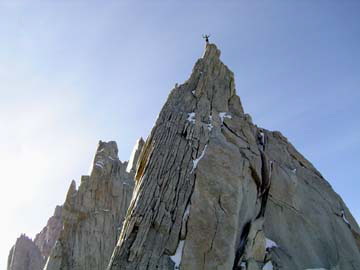 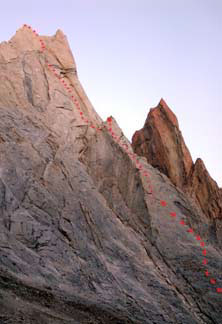
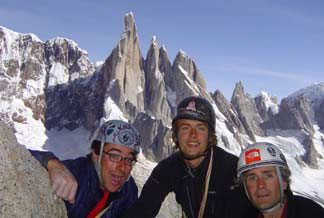 |